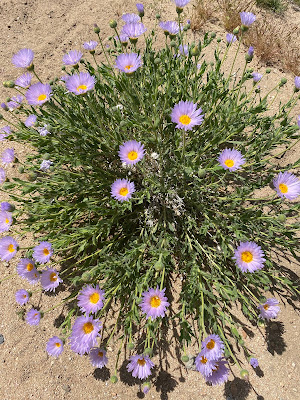The Magical Mojave Desert Spring Show & Tell
MBCA's 2023 Desert-Wise Landscape Tour is an opportunity to consider desert living and gardening with water as a key issue. I invited out-of-town friends to explore the beauty of the Mojave Desert and to learn how others have dealt with the challenges of high desert gardening.
 |
| Purple Aster |
 | |||||||||
| Desert Marigold |
Springtime in the Morongo Basin region
offers a stunning vista awash all over with colorful wildflowers. The desert appears imbued with magic as the ground
shimmers with much loveliness reflected in yellow desert dandelions, purple
Mojave asters, pink cactus flowers and other beauties thanks to higher rainfall
than usual.
The easiest and most sustainable path is to adapt to the environment. Our first stop is a multi-acre natural yard in Yucca Valley, only tended by nature and rain. Their uncultivated yard is abundantly verdant. The desert shoots forth spring's splendor of flowers. Below the Joshua trees, emerges many native flora: yellow desert dandelions and purple flowers, desert marigold, beavertail prickly pear cactus with vivid pink flowers. Tall cholla cactus, creosote and other shrubs form a wild desert landscape.
 | |
| Beavertail Cactus |
 |
| Recirculating water well |
 |
| Rusty or Diesel? |
The water usage for this household is significantly below the average, having reduced water consumption even further from the prior year’s and the water is also shared with two adult brown-haired horses, Rusty & Diesel. The cultivated landscape portion is a small-scale pathway garden around the house composed of native, drought tolerant plants. The stone water well uses recirculated water and is covered with roof for shade to reduce evaporation.
The next place we visited featured a determined vegetable garden aspiration: a small-scale semi-greenhouse to keep the vegetables close together, set up with drip irrigation into the roots, and completely enclosed to keep out the foraging animals.
Some dare grow vegetables and are
willing to tackle the challenges inherent in the high desert environment. The blazing summer heat, the freezing cold
and snow, the intense wind, the local wildlife, and low rainfall are all formidable
challenges specific to the high desert climate.
Clear plastic sheeting covered the low-lying plants to shield them from the wind to keep the soil moist. All these techniques have helped to nurture a cornucopia of vegetables. The gardener said she had abundant harvest of cucumbers and morning glories climbing all over the enclosure and she would situate a chair in the center to bask in the bountiful garden of cucumbers, morning glories, tall corianders, purple lettuces, carrots, and more.
 |
| Sea shell clad desert tortoise sculpture |
 |
| The Wabi Sabi way: transform the cracks. |
 | ||||||||||||||||||
| Thistle? | |
 |
| Desert Dandelion |
Since the first tour, I too have reduced water usage from
prior year based on collecting and using graywater for plant irrigation. This year, I came away from the tour with a renewed interest in water-wise gardening. Water is the magical ingredient of spring's beauty so use it wisely!
Reported by High Desert World


